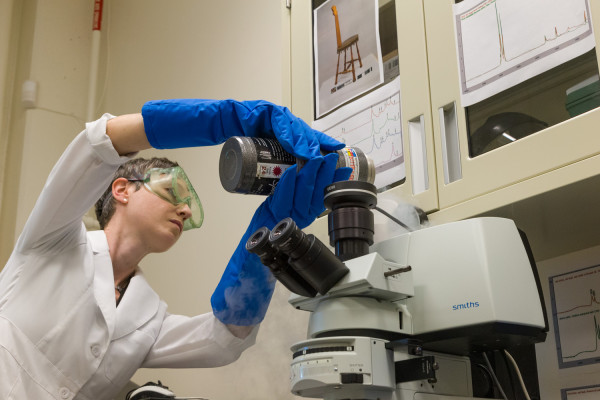 When I give tours of my analytical lab to our guests, everyone’s eyes seem to widen as I introduce them to the Fourier-Transform Infrared Microspectrometer (FTIR for short). It’s definitely a mouthful but it’s also a great friend to us materials analysts!
When I give tours of my analytical lab to our guests, everyone’s eyes seem to widen as I introduce them to the Fourier-Transform Infrared Microspectrometer (FTIR for short). It’s definitely a mouthful but it’s also a great friend to us materials analysts!
I always begin by telling visitors that the most important thing to remember about FTIR is the “IR” part, which stands for Infrared. Because IR energy is something most people are familiar with, that’s usually when I notice everyone’s shoulders start to relax a bit. For those of you who don’t know, IR is the name for that portion of the electromagnetic spectrum that’s just below visible light—in particular, red light. And that’s where the name infra (meaning “below”) red comes from.
Because it is outside the visible spectrum, IR is invisible to the naked eye. Enter the FTIR. Most people are familiar with Infrared radiation as thermal energy (or heat), but it’s also used in night vision devices, infrared telescopes, and even in art conservation labs here at Colonial Williamsburg! We use IR reflectography to visualize the layers underneath a painting or to make faded inscriptions more visible.
 In my lab, the FTIR uses IR energy to analyze materials collected from art and artifacts in our collection. The FTIR analyzes organic materials only. What’s considered organic? Varnishes, adhesives, waxes, oils, plastics, fibers, and even some pigments. It cannot identify inorganics like metals (for that, we would use our XRF spectrometer).
In my lab, the FTIR uses IR energy to analyze materials collected from art and artifacts in our collection. The FTIR analyzes organic materials only. What’s considered organic? Varnishes, adhesives, waxes, oils, plastics, fibers, and even some pigments. It cannot identify inorganics like metals (for that, we would use our XRF spectrometer).
Getting the scope ready for an analytical session is pretty visual. Wearing protective gloves and goggles, I pour liquid nitrogen into the instrument to cool the detector (which has to be very, very cold to operate properly). The result? You’re looking at it! Fog that billows out of the machine and evaporates in mid-air.
 Once the machine has cooled, it’s time for me to view my sample. The sample size can be extremely small. Just how small? We’re talking 10 micrometers, which is 1/10 of the width of the average human hair! Sometimes these samples are so small I cannot see them with my naked eye and I must use a stereomicroscope during preparation. But that’s okay, because we like samples to be as small as possible. It minimizes damage to an artifact.
Once the machine has cooled, it’s time for me to view my sample. The sample size can be extremely small. Just how small? We’re talking 10 micrometers, which is 1/10 of the width of the average human hair! Sometimes these samples are so small I cannot see them with my naked eye and I must use a stereomicroscope during preparation. But that’s okay, because we like samples to be as small as possible. It minimizes damage to an artifact.
During the analysis, IR energy passes through the sample, and some molecular bonds absorb IR energy at particular wavelengths (ours analyzes wavelengths from 4000-650cm). The resulting “IR spectrum” will show a series of peaks corresponding to molecular groups present in the sample. The peak locations, patterns, and intensities can be used to help identify the material, with the help of IR spectral databases for comparison.
For conservators, it can be extremely useful. For instance—identifying the type of adhesive used in an old ceramic repair eliminates a lot of guesswork and chemical testing for an objects conservator who may need to remove it.
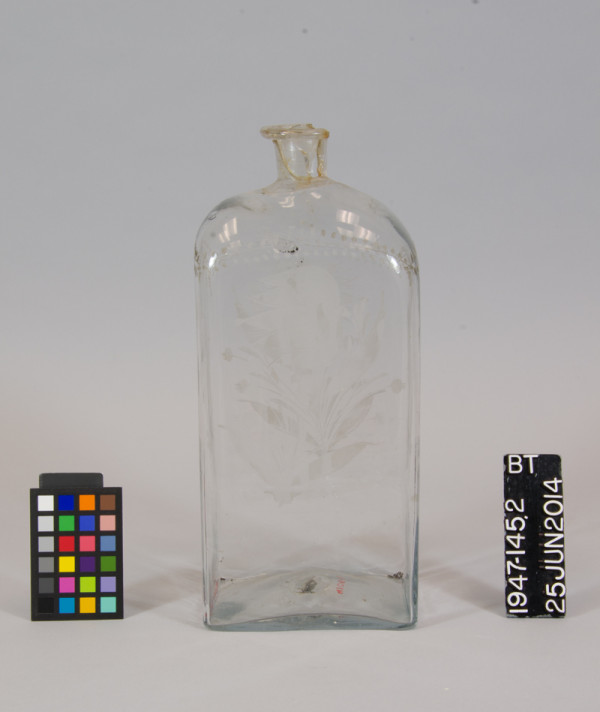 Apothecary bottle, 1947-145,2. Before conservation treatment. The neck and rim of the bottle were previously restored with an unknown adhesive. Removal of this adhesive was necessary for conservation treatment. FTIR is an ideal technique for the analysis of organic materials, such as adhesives.
Apothecary bottle, 1947-145,2. Before conservation treatment. The neck and rim of the bottle were previously restored with an unknown adhesive. Removal of this adhesive was necessary for conservation treatment. FTIR is an ideal technique for the analysis of organic materials, such as adhesives.
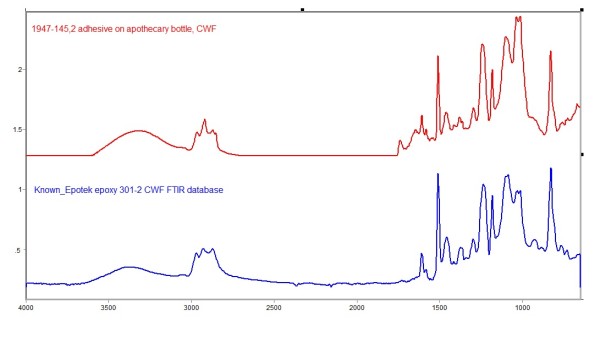 The FTIR analysis determined that the adhesive on the apothecary bottle (red) was an epoxy resin (blue).
The FTIR analysis determined that the adhesive on the apothecary bottle (red) was an epoxy resin (blue).
FTIR also aids in curatorial studies. It’s one of tools used to analyze a theorem stencil in our collection, which is believed to date to the early 19th century. Analysis of the varnish used on the stencil determined it to be a natural resin, most likely a mastic resin (sometimes known as gum mastic), which is an exudate collected from the bark of the pistacia lentiscus tree in the Mediterranean and has been in use since antiquity. In fact, the analysis showed that all of the stencil materials were consistent with an early 19th century date.
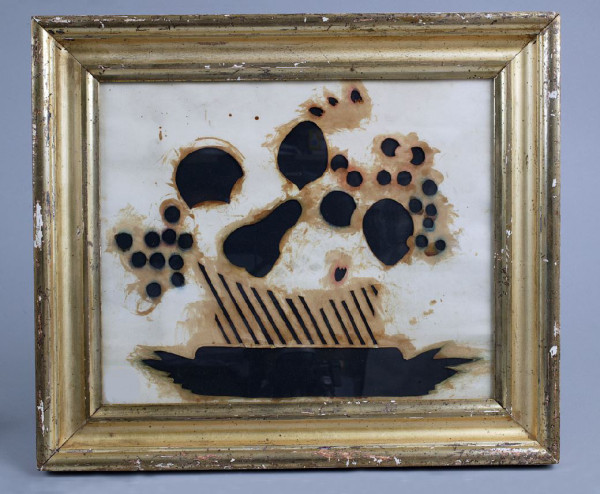 Theorem stencil, 2005.310.3. An unknown type of varnish was applied around the edges of the cutshapes to keep the paper stiff during painting (the varnish has oxidized and turned brown). FTIR is an excellent technique for the identifications of coatings like varnishes.
Theorem stencil, 2005.310.3. An unknown type of varnish was applied around the edges of the cutshapes to keep the paper stiff during painting (the varnish has oxidized and turned brown). FTIR is an excellent technique for the identifications of coatings like varnishes.
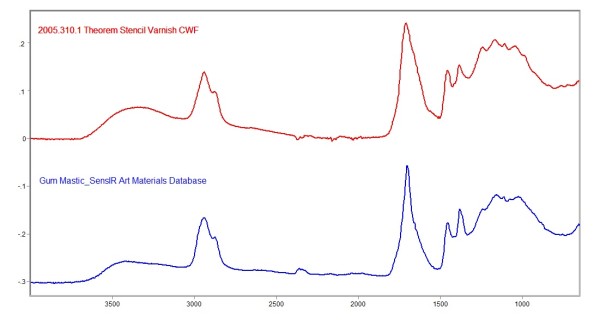 The FTIR analysis determined that the varnish was a natural resin type, the closest spectral match being a Gum Mastic.
The FTIR analysis determined that the varnish was a natural resin type, the closest spectral match being a Gum Mastic.
Each time I sit down at the FTIR, it still amazes me that we can learn so much by irradiating a tiny sample with invisible IR energy. Being able to help the curators, conservators, and visitors better understand our collection is just one of the many parts of my job that I love. And I wouldn’t be able to do it without this amazing piece of technology.
Blogger: Kirsten Moffitt
 Kirsten received her M.S. from the Winterthur/University of Delaware Program in Art Conservation, where she specialized in the conservation and analysis of painted surfaces. As Colonial Williamsburg’s Materials Analyst and Associate Conservator, Kirsten analyzes all types of collection materials including metals, ceramics, textiles, furniture and house paints in the Foundation’s newly established Materials Analysis Laboratory. She loves that her job is a combination of art history, chemistry, and forensics. Kirsten truly loves watching paint dry, and her analytical work was a big contribution to Benjamin Moore’s Williamsburg Collection line.
Kirsten received her M.S. from the Winterthur/University of Delaware Program in Art Conservation, where she specialized in the conservation and analysis of painted surfaces. As Colonial Williamsburg’s Materials Analyst and Associate Conservator, Kirsten analyzes all types of collection materials including metals, ceramics, textiles, furniture and house paints in the Foundation’s newly established Materials Analysis Laboratory. She loves that her job is a combination of art history, chemistry, and forensics. Kirsten truly loves watching paint dry, and her analytical work was a big contribution to Benjamin Moore’s Williamsburg Collection line.
Kirsten loves reading, traveling, and walking her black lab, Ebbie, around the Historic Area.

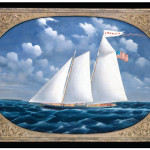
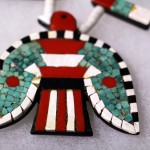
Austin says
Great post - and very good explanations - and fabulous cross-sections too!
Else Travers says
How interesting that so much high tech science is involved in CW’s conservation department. I’m sure your lab tours are full of interesting information.
I wasn’t sure my comment was submitted, but I was fascinated by this story. I was curious about plastics being considered organic. Does the website time-out after a while?
Hi Jeannie! Thanks for your comment. Yes, most plastics are organics, as they are polymers of carbon, oxygen, hydrogen and sometimes nitrogen. Plastics I encounter in my work include cellulose nitrate, cellulose acetate, acrylics, and polyesters. I hope this helps!
Kirsten
Thanks so much for the explanation, Kristen. I’m trying to get my head around that since science is a bit of a stretch for me. Good exercise!
Fascinating story! Who knew how this information was derived. I didn’t know plastics were considered organic, but my training isn’t rooted in the sciences.
THIS is what separates Colonial Williamsburg from the others. The pursuit of the truth in the story telling, through scientific verification and research. Some “historic” sites rely on “best guess” method to entertain visitors rather than researching the facts of the story and telling it like it was. Keep up the good work!